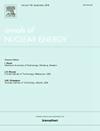Mapping radionuclide concentrations in the UAE using a Gaussian process Machine learning approach
IF 1.9
3区 工程技术
Q1 NUCLEAR SCIENCE & TECHNOLOGY
引用次数: 0
Abstract
This study introduces a machine learning approach for mapping soil radionuclide concentrations in the UAE using Gaussian Process (GP) regression. Aimed at enhancing environmental monitoring and public health, the approach utilizes soil samples from across the UAE to create a radiation map (covering Ra-226, Th-232, and K-40 isotopes). GP regression, known for its proficiency in spatial data interpolation, predicts radionuclide levels in areas without direct testing. This method is adept at managing the non-linear spatial complexities inherent in geographic data, offering both a qualitative and quantitative understanding beneficial for decision-making and further sampling strategies. The results reveal the GP model’s capacity to accurately reflect geographic variances in isotopic concentrations, with RMSE values of 13%, 14%, and 22% for Ra-226, Th-232, and K-40, respectively. The model’s success in learning the geographical variations of the concentrations showcases its potential to guide future research by identifying areas of increased radioactivity risk.
求助全文
约1分钟内获得全文
求助全文
来源期刊

Annals of Nuclear Energy
工程技术-核科学技术
CiteScore
4.30
自引率
21.10%
发文量
632
审稿时长
7.3 months
期刊介绍:
Annals of Nuclear Energy provides an international medium for the communication of original research, ideas and developments in all areas of the field of nuclear energy science and technology. Its scope embraces nuclear fuel reserves, fuel cycles and cost, materials, processing, system and component technology (fission only), design and optimization, direct conversion of nuclear energy sources, environmental control, reactor physics, heat transfer and fluid dynamics, structural analysis, fuel management, future developments, nuclear fuel and safety, nuclear aerosol, neutron physics, computer technology (both software and hardware), risk assessment, radioactive waste disposal and reactor thermal hydraulics. Papers submitted to Annals need to demonstrate a clear link to nuclear power generation/nuclear engineering. Papers which deal with pure nuclear physics, pure health physics, imaging, or attenuation and shielding properties of concretes and various geological materials are not within the scope of the journal. Also, papers that deal with policy or economics are not within the scope of the journal.
 求助内容:
求助内容: 应助结果提醒方式:
应助结果提醒方式:


